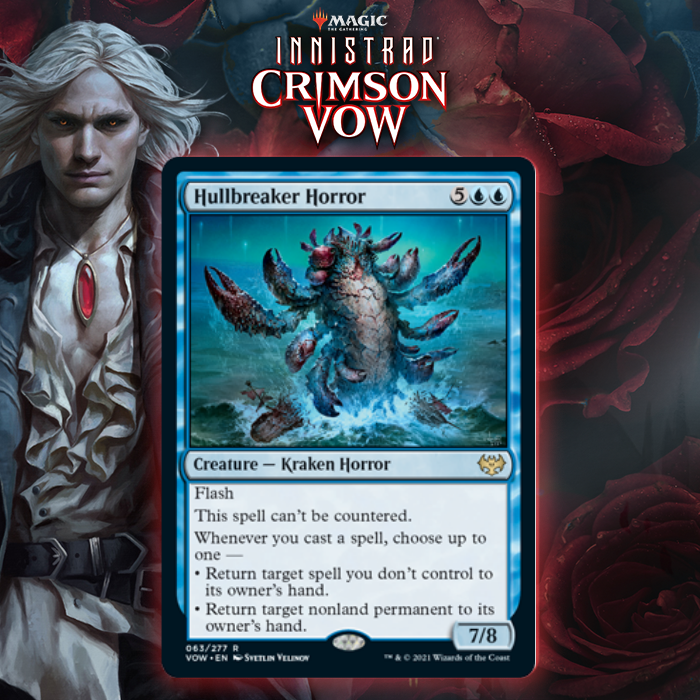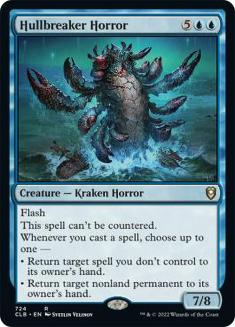– Some idiot paid off by the broken blue seven-drop lobbyists, probably
I didn’t think Innistrad: Crimson Vow Standard was going to go like this for me. Mono-White Aggro❄ and Mono-Green Aggro❄ both got incredible tools to put in decks that were already top-tier. The best color combination got a long-awaited dual land, smoothing out its singular point of weakness. Most importantly, Alrund’s Epiphany survived a banning, seemingly invalidating a large percentage of new cards before they even dipped their toes in the format.
All this left me looking for two types of cards come preview season. Cheap, preferably disruptive threats, and more countermagic to challenge Alrund’s Epiphany on the stack.
So how the hell did I end up here so quickly?

Simply, Hullbreaker Horror is a threat like few that have come before it. Uncounterable blue threats have a long pedigree in Magic and from a design standpoint, they make a lot of sense. You want to force action in games; otherwise, several matchups devolve into “who blinks first,” especially control mirrors. However, if you swing the pendulum too far in favor of the big, uncounterable threat, you run the risk of rendering all the turns that came prior to its appearance irrelevant. While not blue, a textbook example of this problem was Emrakul, the Promised End. Emrakul’s presence meant that all the advantages accrued prior to its casting were reset to zero and the game at that point became only about Emrakul and answering its sizeable body.
That’s not the entirety of why Emrakul crossed the line from “problematic” to “ban-worthy” though. Because its triggered ability impacted opponents’ future turns by deploying their own resources against them, many times its appearance also rendered the turns played after Emrakul’s appearance meaningless as well. The games became solely and completely about Emrakul. Do you see where I’m going with this yet?
Hullbreaker Horror, with its flash speed and ability to bounce your opponent’s threats, does the Emrakul-style reset beautifully. But here’s the messed-up part. Once Hullbreaker Horror enters the battlefield, it often renders the turns played after its arrival meaningless as well. Expensive spells are shut down. Battlefield presence can’t be generated. It’s just Hullbreaker Horror’s world.
Unless you can answer it. But what answers Hullbreaker Horror? The cards people seem to mention the most are Divide by Zero and Fading Hope, and I just don’t know why you’d view these as outs against a flash threat. Yes, they technically interact with Hullbreaker Horror. Unless they’re backed up by a ton of pressure, its not going to matter at all though. Just do it again on your opponent’s next turn. Maybe the best bet is running you out of the surrounding resources needed to leverage a Hullbreaker Horror with things like Go Blank, but once you cross certain resource thresholds Go Blank is downright embarrassing, and its presence in your hand surely impacted your ability to create pressure.
Here’s where I’m at on the format right now. Hullbreaker Horror is the premier end-game, surpassing Alrund’s Epiphany. Since it costs seven mana, the best way to interact with it is hyper-linear aggro. Maybe you can challenge their setup with aggression plus disruption, but the vulnerable points of the uncounterable Hullbreaker Horror are even fewer than those displayed by Izzet Epiphany. In short, meet the new boss, same as the old boss.
So that means it’s time to start playing the various flavors of Hullbreaker Horror, and here’s a little bit of a silver lining for you. I think there are several ways to build promising Hullbreaker Horror decks. Even if they all try to get to the same end-game, we can find some points of interest in how we play the turns until we get to Hullbreaker Horror land. Once we’re there though, all bets are off.
A good starting point is probably getting there as soon as possible.
Creatures (12)
Lands (23)
Spells (25)

Linear Simic Hullbreaker is my gameplan for just turboing out Hullbreaker Horrors in the days before people wrap their heads around how absurd this card really is. The full four Hullbreakers, backed up by plenty of card draw and ramp, ensure that we will get Hullbreaker online early and often and have the necessary gas afterwards to play catch-up. Playing Divide by Zero also helps our post-Hullbreaker resource count, while hopefully slowing opponents down just long enough.
Of course, we know that two aggressive decks are occupying the lion’s share of the early metagame and ignoring their ability to quickly get on the battlefield would be a death sentence. This is where a full playset of Consuming Tide comes in. It should prevent our opponents from getting too wide and even garners us some nice reset value from our Quandrix Cultivators and Prosperous Innkeepers.
There’s not a lot to say about this deck. Make Hullbreakers quickly. Hope they’re good enough. They probably will be. However, once opponents start altering their decks to account for a Hullbreaker meta (honestly, I still am not sure what this looks like or I’d also be writing that article), we may have to give up on linearity and start exploring what I’m sure was Hullbreaker Horror’s intended home — control decks.
Creatures (9)
Lands (21)
Spells (30)

Devout readers of the column will recognize this deck as a successor to a Dollhouse of Horrors list I posted that I was extremely high on last week. Turns out all of the cards in the deck were just incredible on their own and you didn’t need any kind of gimmick to make them shine. If the core here looks familiar, it’s because we share a lot of our DNA with last season’s Izzet Epiphany decks, but we’ve somehow picked up an even better end-game.
Playing Consider over Expressive Iteration is weird, but I’m attempting to get out in front of reality a little bit with these types of decisions. Hullbreaker Horror is a problem card, and more and more decision-making in deckbuilding will be dictated by its existence. Once that happens, you’re going to want access to more cheap instants to both protect and leverage your Hullbreakers and minimize the windows your opponents have to get their own onto the battlefield.
This is my favorite Hullbreaker control list, but I’ve got other flavors up my sleeve, ready to react to whatever the meta brings my way.
Creatures (2)
Planeswalkers (3)
Lands (26)
Spells (29)

Creatures (3)
Lands (24)
Spells (33)

The main points of differentiation between Esper Control and Azorius Control all have to do with removal and mana acceleration. In Azorius Control, we’re able to get some extremely fast Hullbreaker Horrors onto the battlefield with protection almost by accident. This comes from the combination of Teferi, Who Slows the Sunset and The Celestus, a two-card setup using cards we’d be playing anyway capable of bringing us to eight mana on Turn 5.
Granted, this forces a sorcery-speed Hullbreaker Horror, but that’s going to be entirely acceptable against the many decks that just can’t kill the Kraken Horror. The Azorius list also gets to leverage the criminally underrated Thirst for Discovery due to its high basic land count.
Esper Control doesn’t go quite as hard on the ramp side of things, but still finds room for some copies of The Celestus that should also help smooth out any mana woes. The draw here is a diverse removal suite, especially as it relates to our sweepers. Crippling Fear, Shadows’ Verdict, The Meathook Massacre, and Path of Peril all have their place, and since we’re a committed Memory Deluge deck, I don’t mind spreading out amongst all four options.
Path of Peril’s ability to start work on Turn 3 seems especially strong in the current metagame, but not strong enough that we can commit to it 100% as our removal of choice. The same goes for Vanishing Verse, but it’s still a big draw towards adding white.
Another interesting tool for these Esper Decks is Siphon Insight. While I haven’t loved the card in the abstract, an additional meaningful spell that can be played from your graveyard after Hullbreaker Horror comes down has a lot of appeal right now. And I realize it’s a little silly to suggest you can use this card to reduce your opponents’ Hullbreakers by stealing them, but… you can. And Hullbreaker is going to decide so many games that it just might matter.
The kind of simultaneous proactivity and defense Hullbreaker Horror provides is exactly what traditional control has been missing in the Epiphany era, and it makes the idea of tuning these strategies seem worthwhile again. “Tuning” is a very purposeful word choice here, as that’s what these two decks are going to be all about. Even the decision regarding which base to use will come down to expected metagame, and individual card choice is a whole other can of worms. Use these as starting points, but don’t be afraid to shift numbers to get edges against your expected opponents.
Creatures (22)
- 4 Eyetwitch
- 4 Shambling Ghast
- 3 Jadar, Ghoulcaller of Nephalia
- 3 Overcharged Amalgam
- 2 Fell Stinger
- 3 Concealing Curtains
- 3 Hullbreaker Horror
Lands (23)
Spells (15)

Finally, we close out with the most distinctive of my lists today, but it’s designed to show just how far I expect Hullbreaker Horror’s slimy claws to reach into the format. There’s no reason Hullbreaker Horror needs to be in this deck, but there’s also no reason for it not to be. It leverages the many cheap spells you have, is a great place to use your Treasures from Deadly Dispute and Shambling Ghast, and is going to be found reliably with all of your card draw.
Meanwhile, in the background you just have all of the usual Dimir sacrifice stuff going on, backed up by plenty of blue disruption. This deck, as built, plays a little soft to aggro, and I wouldn’t mind a version that just played more removal and Crippling Fear maindeck over the blue disruption. Despite creature density, you have a lot of Zombies and a few x/4s as well, making Crippling Fear less of a liability than you’d expect. Additional Fell Stingers could also help smooth out games against the big bodies of Mono-Green Aggro❄.
I’m now entirely Hullbreaker Horror-focused when it comes to Innistrad: Crimson Vow Standard. When I predicted a long reign for Alrund’s Epiphany’s dominance over Standard, it was because I was assuming that Magic cards would be adhering to reasonable power levels and degrees of interactivity. Hullbreaker Horror does not. It can’t be countered. It has flash. It can return itself to your hand. It resets your opponent’s battlefield. It prevents them from casting spells. And it’s just freaking huge.
If we’re going to have cards like this exist in Standard, it’d be a really good idea to always have a Cranial Extraction effect in the format, because traditional rules of Magic don’t apply to Hullbreaker Horror once it’s castable. Shockingly, I’m back to “play it until they take it away from you”… or make something even more ridiculous, I guess.



